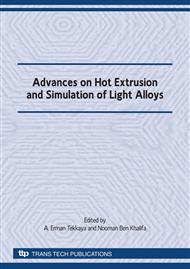p.189
p.197
p.205
p.213
p.221
p.227
p.235
p.241
p.249
Localization of the Shear Zone in Extrusion Processes by Means of Finite Element Analysis
Abstract:
A characteristic feature of extrusion processes is the formation of a shear zone, which separates the deformation zone and the dead metal zone [1, 2]. The deformations occurring in the shear zone cause inner separation and welding effects, which are of great importance for the material flow and the microstructure development of the extruded profiles. The material in the dead metal zone is not participating directly in the forming process but the shape of this zone influences eminently the forming zone and thus the forming of the extruded profile. Furthermore the extreme shear deformation causes according to the Hall-Petch relationship a significant grain refinement in these regions of extruded profiles [3, 4]. So the knowledge on the effects in the shear zone during extrusion processes is fundamental for subsequent numerical investigations on the microstructure development for example regarding quenching techniques. The aim of this study is to localize the formation of the shear zone during extrusion processes by means of the finite element analysis. On the basis of the assumption that separation and welding effects take place in the shear zone, numerical investigations were carried out to indicate these microscopic effects on the macroscopic scale. The considered process was the extrusion of a solid round profile of the alloy EN AW 6082 at 450°C with a punch velocity of 10.5 mm/s. For the localization of the shear zone mechanical parameters were chosen for a shear criterion, which are taken from numerical simulations. A user subroutine was implemented into the FE-models in order to evaluate the shear criterion for the localization of the shear zone. According to [5, 6] the friction model used for the numerical simulations has a strong influence on the formation of the shear zone. In this study a combined friction model according to [7] was used.
Info:
Periodical:
Pages:
221-226
Citation:
Online since:
December 2009
Authors:
Price:
Сopyright:
© 2010 Trans Tech Publications Ltd. All Rights Reserved
Share:
Citation:


